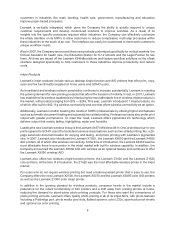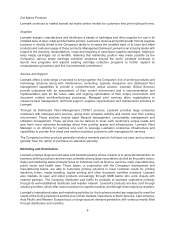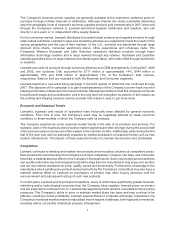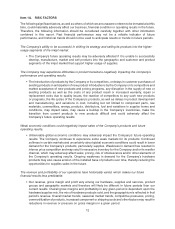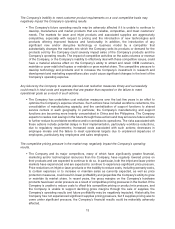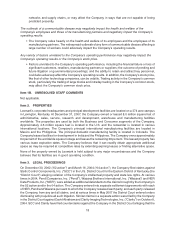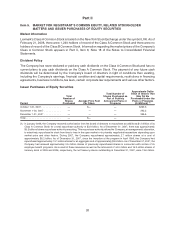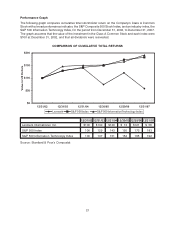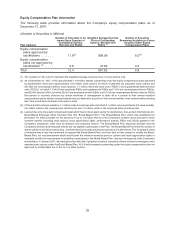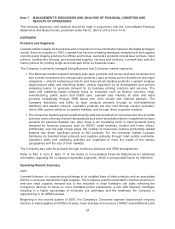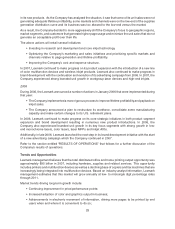Lexmark 2007 Annual Report Download - page 21
Download and view the complete annual report
Please find page 21 of the 2007 Lexmark annual report below. You can navigate through the pages in the report by either clicking on the pages listed below, or by using the keyword search tool below to find specific information within the annual report.increasing global demand in the Company’s industry and other industries. Such delays, disruptions
or shortages may result in lost revenue or in the Company incurring additional costs to meet
customer demand. The Company’s future operating results and its ability to effectively grow or
maintain its market share may be adversely affected if it is unable to address these issues on a
timely basis.
New legislation, fees on the Company’s products or litigation costs required to protect the Company’s
rights may negatively impact the Company’s cost structure, access to components and operating
results.
• The European Union has adopted the Waste Electrical and Electronic Equipment Directive (the
“Directive”) which requires producers of electrical and electronic goods, including printing devices,
to be financially responsible for specified collection, recycling, treatment and disposal of past and
future covered products. The deadline for enacting and implementing the Directive by individual
European Union governments was August 13, 2004 (such legislation, together with the Directive,
the “WEEE Legislation”), although extensions were granted to some countries. Producers were to
be financially responsible under the WEEE Legislation beginning in August 2005. Similar legislation
may be enacted in the future in other jurisdictions as well. The impact of this legislation could
adversely affect the Company’s operating results and profitability.
• Certain countries (primarily in Europe) and/or collecting societies representing copyright owners’
interests have commenced proceedings to impose fees on devices (such as scanners, printers and
multifunction devices) alleging the copyright owners are entitled to compensation because these
devices enable reproducing copyrighted content. Other countries are also considering imposing
fees on certain devices. The amount of fees, if imposed, would depend on the number of products
sold and the amounts of the fee on each product, which will vary by product and by country. The
financial impact on the Company, which will depend in large part upon the outcome of local
legislative processes, the Company’s and other industry participants’ outcome in contesting the
fees and the Company’s ability to mitigate that impact by increasing prices, which ability will depend
upon competitive market conditions, remains uncertain. The outcome of the copyright fee issue
could adversely affect the Company’s operating results and business.
• The European Union has adopted the “RoHS” Directive (Restriction of use of certain Hazardous
Substances) which restricts the use of nine substances in electrical and electronic equipment
placed on the market on or after July 1, 2006. Compliance with the RoHS Directive could create
shortages of certain components or impact continuity of supply that could adversely affect the
Company’s operating results and profitability.
The Company’s inability to obtain and protect its intellectual property and defend against claims of
infringement by others may negatively impact the Company’s operating results.
• The Company’s success depends in part on its ability to develop technology and obtain patents,
copyrights and trademarks, and maintain trade secret protection, to protect its intellectual property
against theft, infringement or other misuse by others. The Company must also conduct its
operations without infringing the proprietary rights of others. Current or future claims of
intellectual property infringement could prevent the Company from obtaining technology of
others and could otherwise materially and adversely affect its operating results or business, as
could expenses incurred by the Company in obtaining intellectual property rights, enforcing its
intellectual property rights against others or defending against claims that the Company’s products
infringe the intellectual property rights of others, that the Company engages in false or deceptive
practices or that its conduct is anti-competitive.
15


